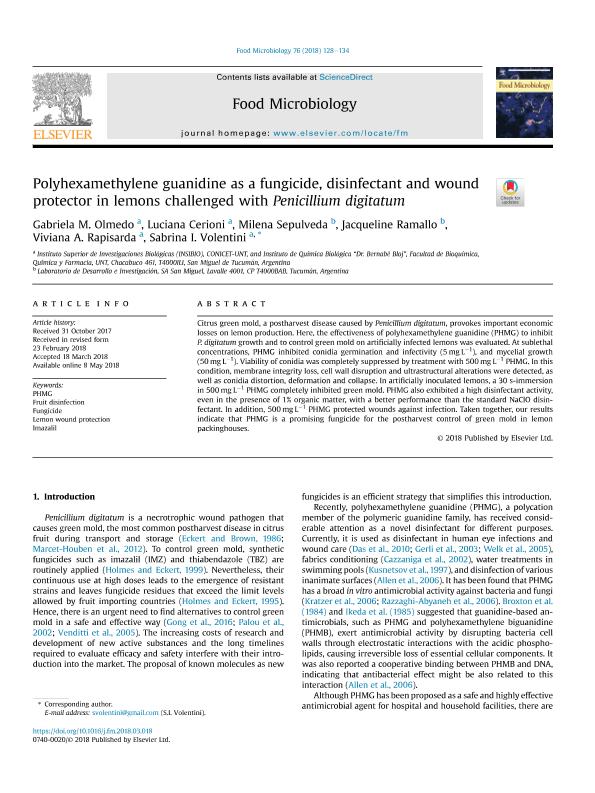Mostrar el registro sencillo del ítem
dc.contributor.author
Olmedo, Gabriela María

dc.contributor.author
Cerioni, Luciana

dc.contributor.author
Sepulveda, Milena

dc.contributor.author
Ramallo, Jacqueline
dc.contributor.author
Rapisarda, Viviana Andrea

dc.contributor.author
Volentini, Sabrina Inès

dc.date.available
2020-03-17T17:08:42Z
dc.date.issued
2018-12-08
dc.identifier.citation
Olmedo, Gabriela María; Cerioni, Luciana; Sepulveda, Milena; Ramallo, Jacqueline; Rapisarda, Viviana Andrea; et al.; Polyhexamethylene guanidine as a fungicide, disinfectant and wound protector in lemons challenged with Penicillium digitatum; Academic Press Ltd - Elsevier Science Ltd; Food Microbiology; 76; 8-12-2018; 128-134
dc.identifier.issn
0740-0020
dc.identifier.uri
http://hdl.handle.net/11336/99849
dc.description.abstract
Citrus green mold, a postharvest disease caused by Penicillium digitatum, provokes important economic losses on lemon production. Here, the effectiveness of polyhexamethylene guanidine (PHMG) to inhibit P. digitatum growth and to control green mold on artificially infected lemons was evaluated. At sublethal concentrations, PHMG inhibited conidia germination and infectivity (5 mg L−1), and mycelial growth (50 mg L−1). Viability of conidia was completely suppressed by treatment with 500 mg L−1 PHMG. In this condition, membrane integrity loss, cell wall disruption and ultrastructural alterations were detected, as well as conidia distortion, deformation and collapse. In artificially inoculated lemons, a 30 s-immersion in 500 mg L−1 PHMG completely inhibited green mold. PHMG also exhibited a high disinfectant activity, even in the presence of 1% organic matter, with a better performance than the standard NaClO disinfectant. In addition, 500 mg L−1 PHMG protected wounds against infection. Taken together, our results indicate that PHMG is a promising fungicide for the postharvest control of green mold in lemon packinghouses.
dc.format
application/pdf
dc.language.iso
eng
dc.publisher
Academic Press Ltd - Elsevier Science Ltd

dc.rights
info:eu-repo/semantics/openAccess
dc.rights.uri
https://creativecommons.org/licenses/by-nc-sa/2.5/ar/
dc.subject
FRUIT DISINFECTION
dc.subject
FUNGICIDE
dc.subject
IMAZALIL
dc.subject
LEMON WOUND PROTECTION
dc.subject
PHMG
dc.subject.classification
Agricultura

dc.subject.classification
Agricultura, Silvicultura y Pesca

dc.subject.classification
CIENCIAS AGRÍCOLAS

dc.title
Polyhexamethylene guanidine as a fungicide, disinfectant and wound protector in lemons challenged with Penicillium digitatum
dc.type
info:eu-repo/semantics/article
dc.type
info:ar-repo/semantics/artículo
dc.type
info:eu-repo/semantics/publishedVersion
dc.date.updated
2019-08-07T14:08:43Z
dc.journal.volume
76
dc.journal.pagination
128-134
dc.journal.pais
Estados Unidos

dc.description.fil
Fil: Olmedo, Gabriela M.. Consejo Nacional de Investigaciones Científicas y Técnicas. Centro Científico Tecnológico Conicet - Tucumán. Instituto Superior de Investigaciones Biológicas. Universidad Nacional de Tucumán. Instituto Superior de Investigaciones Biológicas; Argentina
dc.description.fil
Fil: Cerioni, Luciana. Consejo Nacional de Investigaciones Científicas y Técnicas. Centro Científico Tecnológico Conicet - Tucumán. Instituto Superior de Investigaciones Biológicas. Universidad Nacional de Tucumán. Instituto Superior de Investigaciones Biológicas; Argentina
dc.description.fil
Fil: Sepulveda, Milena. Laboratorio de Desarrollo E Investigación, Sa San Miguel; Argentina
dc.description.fil
Fil: Ramallo, Jacqueline. Laboratorio de Desarrollo E Investigación, Sa San Miguel; Argentina
dc.description.fil
Fil: Rapisarda, Viviana A.. Consejo Nacional de Investigaciones Científicas y Técnicas. Centro Científico Tecnológico Conicet - Tucumán. Instituto Superior de Investigaciones Biológicas. Universidad Nacional de Tucumán. Instituto Superior de Investigaciones Biológicas; Argentina
dc.description.fil
Fil: Volentini, Sabrina I.. Consejo Nacional de Investigaciones Científicas y Técnicas. Centro Científico Tecnológico Conicet - Tucumán. Instituto Superior de Investigaciones Biológicas. Universidad Nacional de Tucumán. Instituto Superior de Investigaciones Biológicas; Argentina
dc.journal.title
Food Microbiology

dc.relation.alternativeid
info:eu-repo/semantics/altIdentifier/url/https://www.sciencedirect.com/science/article/pii/S0740002017310390
dc.relation.alternativeid
info:eu-repo/semantics/altIdentifier/doi/https://doi.org/10.1016/j.fm.2018.03.018
Archivos asociados
